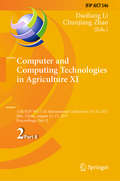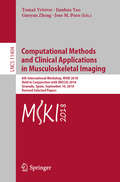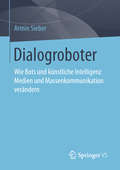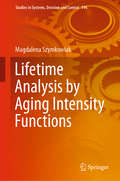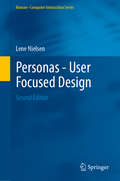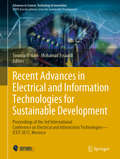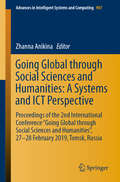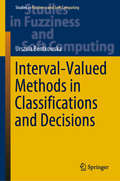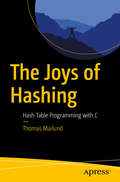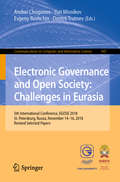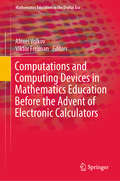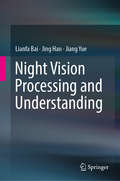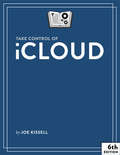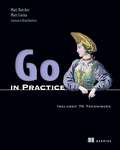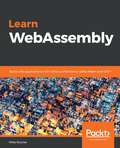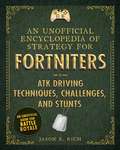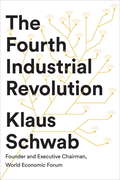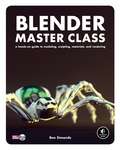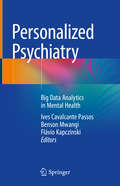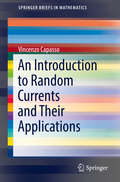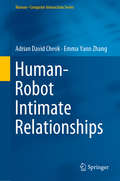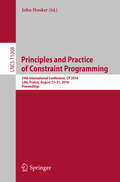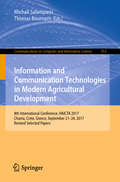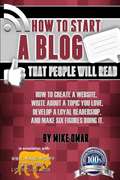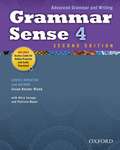- Table View
- List View
Computer and Computing Technologies in Agriculture XI: 11th IFIP WG 5.14 International Conference, CCTA 2017, Jilin, China, August 12-15, 2017, Proceedings, Part II (IFIP Advances in Information and Communication Technology #546)
by Daoliang Li Chunjiang ZhaoThe two volumes IFIP AICT 545 and 546 constitute the refereed post-conference proceedings of the 11th IFIP WG 5.14 International Conference on Computer and Computing Technologies in Agriculture, CCTA 2017, held in Jilin, China, in August 2017.The 100 revised papers included in the two volumes were carefully reviewed and selected from 282 submissions. They cover a wide range of interesting theories and applications of information technology in agriculture. The papers focus on four topics: Internet of Things and big data in agriculture, precision agriculture and agricultural robots, agricultural information services, and animal and plant phenotyping for agriculture.
Computational Methods and Clinical Applications in Musculoskeletal Imaging: 6th International Workshop, MSKI 2018, Held in Conjunction with MICCAI 2018, Granada, Spain, September 16, 2018, Revised Selected Papers (Lecture Notes in Computer Science #11404)
by Tomaž Vrtovec Jianhua Yao Guoyan Zheng Jose M. PozoThis book constitutes the refereed proceedings of the 6th International Workshop on Computational Methods and Clinical Applications for Musculoskeletal Imaging, MSKI 2018, held in conjunction with MICCAI 2018, in Granada, Spain, in September 2018. The 13 workshop papers were carefully reviewed and selected for inclusion in this volume. Topics of interest include all major aspects of musculoskeletal imaging, for example: clinical applications of musculoskeletal computational imaging; computer-aided detection and diagnosis of conditions of the bones, muscles and joints; image-guided musculoskeletal surgery and interventions; image-based assessment and monitoring of surgical and pharmacological treatment; segmentation, registration, detection, localization and visualization of the musculoskeletal anatomy; statistical and geometrical modeling of the musculoskeletal shape and appearance; image-based microstructural characterization of musculoskeletal tissue; novel techniques for musculoskeletal imaging.
Dialogroboter: Wie Bots und künstliche Intelligenz Medien und Massenkommunikation verändern
by Armin SieberTechnologien wie künstliche Intelligenz und Natural Language Programming werden zu Auslösern der sogenannten „Dialogwende“. Darunter versteht dieses Buch die massenweise Verbreitung von autonom sprechenden Sprachdialogsystemen und automatischen Sprachassistenten. Der Autor geht der Frage nach, welche Technologien bereits zur Verfügung stehen oder bald zur Serienreife kommen. Er analysiert konkrete Verwendungen und Einsatzfelder von Bots und stellt sich die Frage, was bei der Planung und Konzeption bedacht werden muss, welche Veränderungen in Medien und Unternehmenskommunikation zu erwarten sind. Das Buch beleuchtet darüber hinaus auch die psychosozialen Folgen, die auf unsere Gesellschaft zukommen, wenn Sprachdialogsysteme in großer Zahl zum Einsatz kommen.
Lifetime Analysis by Aging Intensity Functions (Studies in Systems, Decision and Control #196)
by Magdalena SzymkowiakThis book addresses a range of aging intensity functions, which make it possible to measure and compare aging trends for lifetime random variables. Moreover, they can be used for the characterization of lifetime distributions, also with bounded support. Stochastic orders based on the aging intensities, and their connections with some other orders, are also discussed. To demonstrate the applicability of aging intensity in reliability practice, the book analyzes both real and generated data. The estimated, properly chosen, aging intensity function is mainly recommended to identify data’s lifetime distribution, and secondly, to estimate some of the parameters of the identified distribution. Both reliability researchers and practitioners will find the book a valuable guide and source of inspiration.
Personas - User Focused Design: User Focused Design (Human–Computer Interaction Series #15)
by Lene NielsenPeople relate to other people, not to simplified types or segments. This is the concept that underpins this book. Personas, a user centered design methodology, covers topics from interaction design within IT, through to issues surrounding product design, communication, and marketing. Project developers need to understand how users approach their products from the product’s infancy, and regardless of what the product might be. Developers should be able to describe the user of the product via vivid depictions, as if they – with their different attitudes, desires and habits – were already using the product. In doing so they can more clearly formulate how to turn the product's potential into reality. Based on 20 years’ experience in solving problems for businesses and 15 years of research, currently at the IT University of Copenhagen, Lene Nielsen is Denmark’s leading expert in the persona method. She has a PhD in personas and scenarios, and through her research and practical experiences has developed her own approach to the method – 10 Steps to Personas. This second edition of Personas – User Focused Design presents a step-by-step methodology of personas which will be of interest to developers of IT, communications solutions and innovative products. This book also includes three new chapters and considerable expansion on the material in the first edition.
Recent Advances in Electrical and Information Technologies for Sustainable Development: Proceedings of the 3rd International Conference on Electrical and Information Technologies — ICEIT 2017, Morocco (Advances in Science, Technology & Innovation)
by Soumia El Hani Mohamad EssaaidiThe book includes the best extended papers which were selected from the 3rd International Conference of Electrical and Information Technologies (ICEIT 2017, Morocco). The book spans two inter-related research domains which shaped modern societies, solved many of their development problems, and contributed to their unprecedented economic growth and social welfare. Selected papers are based on original and high quality research. They were peer reviewed by experts in the field. They are grouped into five parts. Part I deals with Power System and Electronics topics that include Power Electronics & Energy Conversion, Actuators & Micro/Nanotechnology, etc. Part II relates to Control Systems and their applications. Part III concerns the topic of Information Technology that basically includes Smart Grid, Information Security, Cloud Computing Distributed, Big Data, etc. Part IV discusses Telecommunications and Vehicular Technologies topics that include, Green Networking and Communications, Wireless Ad-hoc and Sensor Networks, etc. Part V covers Green Applications and Interdisciplinary topics, that include intelligent and Green Technologies for Transportation Systems, Smart Cities, etc. This book offers a good opportunity for young researchers, novice scholars and whole academic sphere to explore new trends in Electrical and information Technologies.
Going Global through Social Sciences and Humanities: Proceedings of the 2nd International Conference “Going Global through Social Sciences and Humanities”, 27-28 February 2019, Tomsk, Russia (Advances in Intelligent Systems and Computing #907)
by Zhanna AnikinaThis book presents contributions submitted to the 2nd international conference Going Global through Social Sciences and Humanities (GGSSH 2019) held in Tomsk, Russia on 27–28 February 2019. The conference focused on such issues as interdisciplinary pedagogy, language teaching and learning, cultural studies and linguistics, particularly highlighting global academic integration and professional development for research. As such, the event provided a platform for discussions and sharing publication activities, to help Russian academics to take first steps toward global research.Showcasing the ongoing Russian research in focus areas, this book is of interest to a diverse academic audience working in social sciences and humanities, particularly those from the post-Soviet countries.
Interval-Valued Methods in Classifications and Decisions (Studies in Fuzziness and Soft Computing #378)
by Urszula BentkowskaThis book describes novel algorithms based on interval-valued fuzzy methods that are expected to improve classification and decision-making processes under incomplete or imprecise information. At first, it introduces interval-valued fuzzy sets. It then discusses new methods for aggregation on interval-valued settings, and the most common properties of interval-valued aggregation operators. It then presents applications such as decision making using interval-valued aggregation, and classification in case of missing values. Interesting applications of the developed algorithms to DNA microarray analysis and in medical decision support systems are shown. The book is intended not only as a timely report for the community working on fuzzy sets and their extensions but also for researchers and practitioners dealing with the problems of uncertain or imperfect information.
The Joys of Hashing: Hash Table Programming with C
by Thomas MailundBuild working implementations of hash tables, written in the C programming language. This book starts with simple first attempts devoid of collision resolution strategies, and moves through improvements and extensions illustrating different design ideas and approaches, followed by experiments to validate the choices. Hash tables, when implemented and used appropriately, are exceptionally efficient data structures for representing sets and lookup tables, providing low overhead, constant time, insertion, deletion, and lookup operations. The Joys of Hashing walks you through the implementation of efficient hash tables and the pros and cons of different design choices when building tables. The source code used in the book is available on GitHub for your re-use and experiments.What You Will LearnMaster the basic ideas behind hash tablesCarry out collision resolution, including strategies for handling collisions and their consequences for performanceResize or grow and shrink tables as neededStore values by handling when values must be stored with keys to make general sets and mapsWho This Book Is ForThose with at least some prior programming experience, especially in C programming.
Electronic Governance and Open Society: 5th International Conference, EGOSE 2018, St. Petersburg, Russia, November 14-16, 2018, Revised Selected Papers (Communications in Computer and Information Science #947)
by Andrei Chugunov Yuri Misnikov Evgeny Roshchin Dmitrii TrutnevThis book constitutes the refereed proceedings of the 5th Conference on AElectronic Governance and Open Society: Challenges in Eurasia, EGOSE 2018, held in St. Petersburg, Russia, in November 2018. The 36 revised full papers were carefully reviewed and selected from 98 submissions. The papers are organized in topical sections on smart city infrastructure, policy; digital privacy, rights,security;data science, machine learning, algorithms, computational linguistics; digital public administration, economy, policy; digital services, values, inclusion; digital democracy, participation, security, communities, social media, activism; social media discourse analysis; digital data, policy modeling; digital government, administration, communication.
Computations and Computing Devices in Mathematics Education Before the Advent of Electronic Calculators (Mathematics Education in the Digital Era #11)
by Alexei Volkov Viktor FreimanThis volume traces back the history of interaction between the “computational” or “algorithmic” aspects of elementary mathematics and mathematics education throughout ages. More specifically, the examples of mathematical practices analyzed by the historians of mathematics and mathematics education who authored the chapters in the present collection show that the development (and, in some cases, decline) of counting devices and related computational practices needs to be considered within a particular context to which they arguably belonged, namely, the context of mathematics instruction; in their contributions the authors also explore the role that the instruments played in formation of didactical approaches in various mathematical traditions, stretching from Ancient Mesopotamia to the 20th century Europe and North America.
Night Vision Processing and Understanding
by Lianfa Bai Jing Han Jiang YueThis book systematically analyses the latest insights into night vision imaging processing and perceptual understanding as well as related theories and methods. The algorithm model and hardware system provided can be used as the reference basis for the general design, algorithm design and hardware design of photoelectric systems. Focusing on the differences in the imaging environment, target characteristics, and imaging methods, this book discusses multi-spectral and video data, and investigates a variety of information mining and perceptual understanding algorithms. It also assesses different processing methods for multiple types of scenes and targets.Taking into account the needs of scientists and technicians engaged in night vision optoelectronic imaging detection research, the book incorporates the latest international technical methods. The content fully reflects the technical significance and dynamics of the new field of night vision. The eight chapters cover topics including multispectral imaging, Hadamard transform spectrometry; dimensionality reduction, data mining, data analysis, feature classification, feature learning; computer vision, image understanding, target recognition, object detection and colorization algorithms, which reflect the main areas of research in artificial intelligence in night vision.The book enables readers to grasp the novelty and practicality of the field and to develop their ability to connect theory with real-world applications. It also provides the necessary foundation to allow them to conduct research in the field and adapt to new technological developments in the future.
Take Control of iCloud (6.0)
by Joe KisselliCloud is Apple’s suite of internet services. This book helps you make sense of iCloud, configure it for your needs, and choose the best ways of using each feature.
Go in Practice
by Matt Butcher Matt FarinaThis practical handbook builds on the foundational concepts of the Go language and introduces specific strategies you can use in your day-to-day applications. <P><P>You'll learn techniques for building web services, using Go in the cloud, testing and debugging, routing, network applications, and much more. <P><P>After finishing this book, you will be ready to build sophisticated cloud-native Go applications.
Learn WebAssembly: Build web applications with native performance using Wasm and C/C++
by Mike RourkeIn the first definitive guide on WebAssembly, you’ll learn how you can wield this new technology to break through the current barriers of web development and build an entirely new class of performant applications .Key FeaturesGenerate WebAssembly modules from C and C++ using Emscripten and interact with these modules in the browser Learn how to use WebAssembly outside of the browser and load modules using Node.js Build a high-performance application using C and WebAssembly and port an existing C++ game to WebAssembly using Emscripten Book DescriptionWebAssembly is a brand-new technology that represents a paradigm shift in web development. This book aims to teaches programmers how to leverage this technology to write high- performance applications that run in the browser. This book will introduces you to the powerful WebAssembly concepts of WebAssembly that willto help you write lean and powerful web applications with native performance.You will start with the evolution of web programming, the state of things today, and what can be done with the advent and release of WebAssembly. We take a look at the journey from JavaScript to asm.js to WebAssembly. We then move on to analyzinge the anatomy of a WebAssembly module and the relationship between the binary and text formats, along with the corresponding JavaScript API.Further on, weyou'll implement all the techniques you've learned by to building a high-performance application using C and WebAssembly, and then port an existing game written in C++ to WebAssembly using Emscripten.By the end of this book, you would will be well-equipped to create high-performance applications and games for the web using WebAssembly.What you will learnLearn how WebAssembly came to be and its associated elements (text format, module, and JavaScript API)Create, load, and debug a WebAssembly module (editor and compiler/toolchain)Build a high-performance application using C and WebAssemblyExtend WebAssembly’s feature set using Emscripten by porting a game written in C++Explore upcoming features of WebAssembly, Node.js integration, and alternative compilation methodsWho this book is forIf you are a web developer or C/C++ programmer keen to leverage the powerful technology of WebAssembly to build high-performance web applications, then this book is for you.
An Unofficial Encyclopedia of Strategy for Fortniters: ATK Driving Techniques, Challenges, and Stunts
by Jason R. RichMake the most of your All Terrain Kart in Fortnite Battle Royale! An Unofficial Encyclopedia of Strategy for Fortniters: ATK Driving Techniques, Challenges, and Stunts is a comprehensive driving manual, teaching you how to find and effectively drive or ride an ATK during a match. <P><P>From basic driving techniques and exploration of the island to advanced ways to utilize an ATK offensively and defensively during any match, this guide runs the gamut of ATK optimization. By reading this double-length guide, you’ll learn all about Fortnite Battle Royale and how to survive in a wide range of situations, using the weapons, ammo, loot items, and resources available to them. Master the terrain and use it to your tactical advantage during high-intensity firefights and all-out battles! <P><P>Take an “A to Z” tour of the mysterious island and learn what to expect at each labeled and unlabeled point of interest Discover strategies for surviving in those areas once they arrive Survive and win battles in different terrain, including cities, farms, factories, underground tunnels, junkyards, open valleys, water, etc. Travel greater distances around the island armed with better strategy
The Fourth Industrial Revolution: A Guide To Building A Better World
by Klaus SchwabWorld-renowned economist Klaus Schwab, Founder and Executive Chairman of the World Economic Forum, explains that we have an opportunity to shape the fourth industrial revolution, which will fundamentally alter how we live and work. Schwab argues that this revolution is different in scale, scope and complexity from any that have come before. Characterized by a range of new technologies that are fusing the physical, digital and biological worlds, the developments are affecting all disciplines, economies, industries and governments, and even challenging ideas about what it means to be human. Artificial intelligence is already all around us, from supercomputers, drones and virtual assistants to 3D printing, DNA sequencing, smart thermostats, wearable sensors and microchips smaller than a grain of sand. But this is just the beginning: nanomaterials 200 times stronger than steel and a million times thinner than a strand of hair and the first transplant of a 3D printed liver are already in development. Imagine "smart factories" in which global systems of manufacturing are coordinated virtually, or implantable mobile phones made of biosynthetic materials. The fourth industrial revolution, says Schwab, is more significant, and its ramifications more profound, than in any prior period of human history. He outlines the key technologies driving this revolution and discusses the major impacts expected on government, business, civil society and individuals. Schwab also offers bold ideas on how to harness these changes and shape a better future--one in which technology empowers people rather than replaces them; progress serves society rather than disrupts it; and in which innovators respect moral and ethical boundaries rather than cross them. We all have the opportunity to contribute to developing new frameworks that advance progress.From the Hardcover edition.
Blender Master Class: A Hands-On Guide to Modeling, Sculpting, Materials, and Rendering
by Ben SimondsBlender is a powerful and free 3D graphics tool used by artists and designers worldwide. But even experienced designers can find it challenging to turn an idea into a polished piece.For those who have struggled to create professional-quality projects in Blender, author Ben Simonds offers this peek inside his studio. You’ll learn how to create 3D models as you explore the creative process that he uses to model three example projects: a muscular bat creature, a futuristic robotic spider, and ancient temple ruins. Along the way, you’ll master the Blender interface and learn how to create and refine your own models.You’ll also learn how to:–Work with reference and concept art in Blender and GIMP to make starting projects easier–Block in models with simple geometry and build up more complex forms–Use Blender’s powerful sculpting brushes to create detailed organic models–Paint textures with Blender and GIMP and map them onto your 3D artwork–Light, render, and composite your models to create striking imagesEach chapter walks you through a piece of the modeling process and offers detailed explanations of the tools and concepts used. Filled with full-color artwork and real-world tips, Blender Master Class gives you the foundation you need to create your own stunning masterpieces.DVD includes files for each project in the book, as well as extra textures, brushes, and other resources.Covers Blender 2.6x
Personalized Psychiatry: Big Data Analytics in Mental Health
by Ives Cavalcante Passos Benson Mwangi Flávio KapczinskiThis book integrates the concepts of big data analytics into mental health practice and research.Mental disorders represent a public health challenge of staggering proportions. According to the most recent Global Burden of Disease study, psychiatric disorders constitute the leading cause of years lost to disability. The high morbidity and mortality related to these conditions are proportional to the potential for overall health gains if mental disorders can be more effectively diagnosed and treated. In order to fill these gaps, analysis in science, industry, and government seeks to use big data for a variety of problems, including clinical outcomes and diagnosis in psychiatry. Multiple mental healthcare providers and research laboratories are increasingly using large data sets to fulfill their mission. Briefly, big data is characterized by high volume, high velocity, variety and veracity of information, and to be useful it must be analyzed, interpreted, and acted upon. As such, focus has to shift to new analytical tools from the field of machine learning that will be critical for anyone practicing medicine, psychiatry and behavioral sciences in the 21st century. Big data analytics is gaining traction in psychiatric research, being used to provide predictive models for both clinical practice and public health systems. As compared with traditional statistical methods that provide primarily average group-level results, big data analytics allows predictions and stratification of clinical outcomes at an individual subject level.Personalized Psychiatry – Big Data Analytics in Mental Health provides a unique opportunity to showcase innovative solutions tackling complex problems in mental health using big data and machine learning. It represents an interesting platform to work with key opinion leaders to document current achievements, introduce new concepts as well as project the future role of big data and machine learning in mental health.
An Introduction to Random Currents and Their Applications (SpringerBriefs in Mathematics)
by Vincenzo CapassoThis book introduces random currents by presenting underlying mathematical methods necessary for applications. The theory of currents is an advanced topic in geometric measure theory that extends distribution to linear functionals within the space of differential forms of any order. Methods to extend random distributions to random currents are introduced and analyzed in this book. Beginning with an overview of mathematical aspects of the theory of currents, this book moves on to examine applications in medicine, material science, and image analysis. Applied researchers will find the practical modern mathematical methods along with the detailed appendix useful to stimulate new applications and research.
Human–Robot Intimate Relationships (Human–Computer Interaction Series)
by Adrian David Cheok Emma Yann ZhangThe idea of humans falling in love with artificial beings is not a modern conception. Our relationship with artificial partners has come a long way since Pygmalion and his ivory lover. In recent years, there has been a strong upsurge of interest and discussions in the various aspects of intimate relationships between humans and artificial partners. This interest is evidenced by the increase in media coverage, TV documentaries and films on this topic, as well as the active research efforts within the academic community. This book provides a comprehensive collection and overview of the latest development in the field of intimate relationships between humans and artificial partners, in particular robots and virtual agents. It includes relevant research work undertaken by the authors, the latest advancements in technology and commercial products, and future predictions and insights from leading experts in the area. This book contains an in-depth discussion of the engineering, philosophical, psychological, ethical, and sociological implications of relationships with artificial companions. It also gives a glimpse of some future directions of artificial intelligence, human-computer love and sexual interaction, robotics engineering etc. It is a great resource for researchers and professionals working in these areas. The narrative style of the book also makes it an enjoyable and educational read for everyone.
Principles and Practice of Constraint Programming: 24th International Conference, Cp 2018, Lille, France, August 27-31, 2018, Proceedings (Lecture Notes in Computer Science #11008)
by John HookerThis book constitutes the proceedings of the 24th International Conference on Principles and Practice of Constraint Programming, CP 2018, held in Lille, France, in August 2018.The 41 full and 9 short papers presented in this volume were carefully reviewed and selected from 114 submissions. They deal with all aspects of computing with constraints including theory, algorithms, environments, languages, models, systems, and applications such as decision making, resource allocation, scheduling, configuration, and planning. The papers were organized according to the following topics/tracks: main technical track; applications track; CP and data science; CP and music; CP and operations research; CP, optimization and power system management; multiagent and parallel CP; and testing and verification.
Information and Communication Technologies in Modern Agricultural Development: 8th International Conference, Haicta 2017, Chania, Crete, Greece, September 21-24, 2017, Revised Selected Papers (Communications in Computer and Information Science #953)
by Michail Salampasis Thomas BournarisThis book constitutes the thoroughly refereed post-conference proceedings of the 8th International Conference on Information and Communication Technologies in Agriculture, Food and Environment, HAICTA 2017, held in Chania, Crete, Greece, in September 2017. <p><p> The 14 revised full papers presented in this book were carefully selected from the 55 accepted full papers out of 124 submissions. The selected papers span across various subjects, from ICT innovations and smart farming, to decision support systems, as well as precision farming, disease diagnosis using mobile devices, IoT for monitoring and controlling animal production, sensor-based solutions, GIS-based water management, environmental planning, information systems for monitoring of fish stocks and fisheries, information management in the agri-food sector, and forestry planning and management.
How to Start a Blog that People Will Read
by Mike OmarEvaluate business ideas much more intelligently once you've gone through this whole process. This is because you will understand the fundamentals of keyword research & analysis, traffic & lead generation, social & affiliate marketing, monetization & conversion testing, and traffic analysis. These skills will help you immensely in ANY business you ever decide to start.
Grammar Sense 4
by Susan KesnerGrammar Sense is a four-level discourse-based grammar series which focuses on the connection between form, meaning, and use of English structures. The series is based on the fundamental premise that English grammar is learnable and teachable if it is systematically organized and explained. Grammar Sense implements linguistic and applied linguistic research on how, where, when, and why native speakers use English structures, and how non-native speakers learn them. This series provides learners with a true understanding of how grammar is used in authentic contexts. Grammar is presented in discourse rather than in isolated sentences which allows the students to understand English grammar in real life situations.
